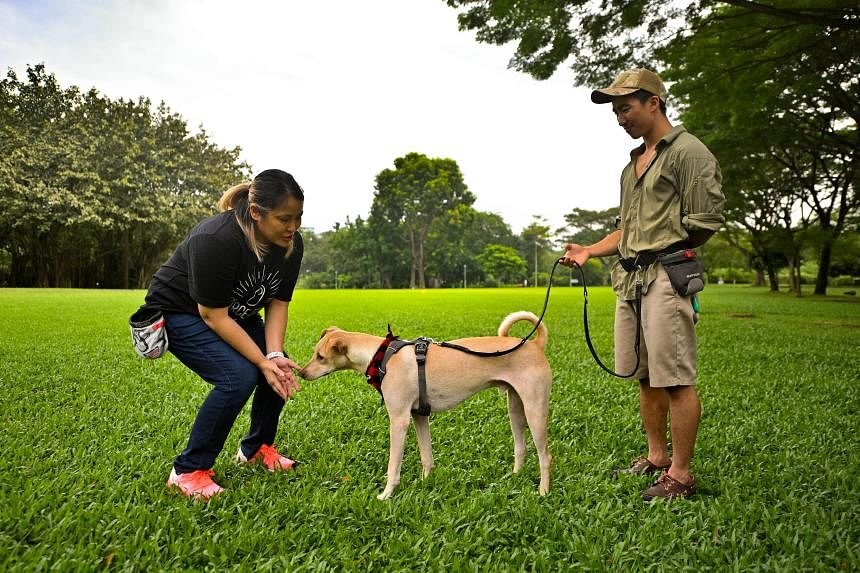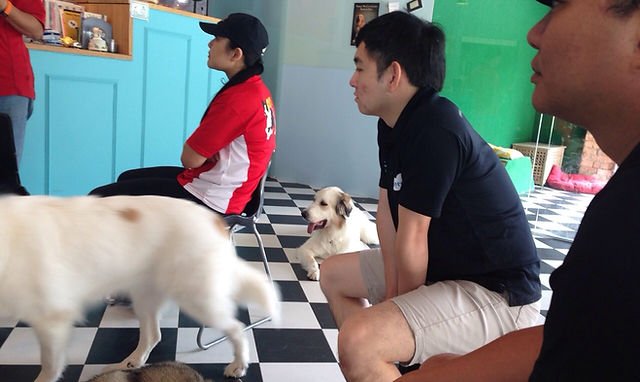Table of Contents
If you’ve ever dreamed of working with dogs and helping them lead happy and obedient lives, becoming a dog trainer in Singapore might be the perfect career path for you. From teaching basic commands to addressing behavioral issues, dog trainers play a crucial role in ensuring the well-being of our furry friends. In this article, we will outline the steps you need to take to embark on this rewarding journey, guiding you through the necessary certifications, hands-on experience, and skills needed to become a successful dog trainer in Singapore. So, grab a leash and get ready to learn!

Education and Experience Requirements
Minimum Education
To become a dog trainer, there is no specific minimum educational requirement. However, having at least a high school diploma or equivalent is recommended. A solid educational foundation can provide the necessary skills in communication, organization, and critical thinking, which are essential for a successful career as a dog trainer.
Relevant Degrees or Certifications
While not mandatory, obtaining relevant degrees or certifications in animal behavior, dog training, or a related field can greatly enhance your credibility and knowledge as a dog trainer. There are numerous programs and universities that offer courses and degrees in canine behavior and training. Some popular certifications include the Certification Council for Professional Dog Trainers (CCPDT) and the International Association of Canine Professionals (IACP).
Experience with Dogs
Having hands-on experience with dogs is crucial in becoming a competent dog trainer. Spending time with dogs, whether through dog ownership, volunteering at shelters, or working as a dog walker, helps you develop a deep understanding of their behavior, needs, and communication. This experience allows you to recognize different types of dog behavior and adapt your training techniques accordingly.
Experience with Training
While experience with dogs is important, it is equally essential to have experience in training dogs. Whether through personal training of your own dogs or assisting professional trainers, gaining practical experience in training dogs helps you understand various training methods and techniques. It also allows you to develop the skills needed to effectively teach dogs and guide their owners.
Experience with Different Breeds
Dogs come in a wide variety of breeds, each with its own unique characteristics and behavior traits. It is important for a dog trainer to have experience working with different breeds to understand their specific needs and challenges. By working with different breeds, you will gain valuable insights into how to tailor your training approaches to suit the individual characteristics and temperaments of each dog.
Understanding Dog Behavior and Psychology
Learning Canine Body Language
In order to effectively communicate with dogs and understand their behavior, it is crucial to learn and interpret their body language. Dogs use various body postures, facial expressions, and tail movements to express their emotions and intentions. By studying canine body language, you will be able to recognize signs of fear, stress, aggression, or relaxation, which will assist you in assessing the emotional state of the dogs you are working with.
Studying Dog Psychology
A solid understanding of dog psychology is essential for any aspiring dog trainer. By studying dog psychology, you will gain insight into how dogs think, learn, and perceive the world around them. Knowledge of basic learning theory, motivation, and reinforcement will allow you to develop effective training techniques and strategies that are tailored to each dog’s individual needs.
Understanding Breed-Specific Traits
Different dog breeds have distinct behavior patterns and tendencies due to their genetic makeup. It is crucial for a dog trainer to develop an understanding of breed-specific traits in order to effectively train and handle different breeds. Understanding these traits will enable you to tailor your training methods to suit the specific needs and characteristics of each breed.
Observing Dog Group Dynamics
Dogs are highly social animals that naturally form hierarchical structures within groups. Observing dog group dynamics can provide valuable insight into how dogs interact, communicate, and establish their social roles. By studying dog group dynamics, you will be better equipped to manage group training sessions and address any potential conflicts or challenges that may arise during training.

Gaining Practical Training Skills
Working as an Assistant Trainer
An excellent way to gain practical training skills is by working as an assistant trainer under the guidance of an experienced professional. This hands-on experience will allow you to observe and learn from a seasoned expert, providing insights into effective training techniques and strategies. As an assistant trainer, you will have the opportunity to work directly with dogs and their owners, hone your training skills, and gain invaluable real-world experience.
Apprenticeship under a Professional Dog Trainer
Another pathway to gaining practical training skills is by undertaking an apprenticeship under a professional dog trainer. This option provides a more hands-on and intensive learning experience, allowing you to work closely with a mentor trainer and actively participate in training sessions. Through this apprenticeship, you will learn the nuances of training various breeds, as well as develop your own style and methods of training.
Volunteering at Animal Shelters
Volunteering at animal shelters is not only a fulfilling way to give back to the community but also an excellent opportunity to gain practical training skills. Animal shelters often have a variety of dogs with different temperaments and behavior issues, providing an ideal environment to practice and refine your training techniques. Volunteering allows you to work with dogs from various backgrounds and experiences, further enhancing your training abilities and understanding.
Participating in Workshops and Seminars
Attending workshops and seminars conducted by reputable dog trainers and behaviorists is a great way to expand your knowledge and gain practical training skills. These events often cover a wide range of topics, including advanced training techniques, behavior modification, and dog handling skills. Participating in workshops and seminars exposes you to different training methods and approaches, allowing you to constantly update your skill set and stay ahead of industry trends.
Building Knowledge in Training Techniques
Positive Reinforcement Training
Positive reinforcement training is a widely recognized and effective training method that focuses on rewarding desirable behavior rather than punishing undesirable behavior. By using rewards such as treats, praise, or play, dogs are motivated to repeat behaviors that are rewarded, resulting in the learning of new skills and behaviors. Positive reinforcement training promotes a trusting and positive relationship between the dog and trainer.
Clicker Training
Clicker training is a form of positive reinforcement training that utilizes a small handheld device called a clicker. The clicker is used as a conditioned reinforcer to mark and capture desirable behaviors at the precise moment they occur. Clicker training helps dogs quickly understand the connection between their actions and the reward, facilitating efficient learning and communication during training sessions.
Reward-Based Training
Reward-based training focuses on utilizing rewards, such as treats or toys, to motivate and reinforce desired behaviors. It emphasizes the power of positive reinforcement to create a strong bond between the dog and trainer. By rewarding the dog for appropriate behaviors, this training technique encourages dogs to repeat those behaviors willingly.
Redirecting Undesirable Behavior
In addition to teaching desirable behaviors, a skilled dog trainer must be adept at redirecting and managing undesirable behaviors. By redirecting the dog’s focus onto more appropriate activities or behaviors, trainers can effectively discourage and replace unwanted behaviors. This technique involves identifying the underlying causes of the behavior and implementing training methods that address those causes.
Understanding Punishment-Free Methods
Modern dog training methods have shifted away from punishment-based training techniques. Instead, utilizing punishment-free methods emphasizes the use of positive reinforcement and reward-based training. Punishment-free training focuses on helping dogs develop trust and a positive association with training, resulting in a cooperative and eager learner.

Learning Pedagogy and Instruction Skills
Preparing and Organizing Training Sessions
A key aspect of being a dog trainer is the ability to plan and organize effective training sessions. This involves carefully selecting exercises and activities that align with the training goals and needs of both the dog and their owner. Preparing training sessions requires setting clear objectives, creating a structured lesson plan, and ensuring all necessary equipment and resources are readily available.
Creating Lesson Plans
Developing comprehensive lesson plans is crucial for delivering effective and organized training sessions. Lesson plans should outline the objectives, goals, and activities for each training session, providing a clear roadmap for both the trainer and the dog owner. Well-designed lesson plans allow for consistency, progression, and evaluation of the dog’s progress throughout the training program.
Developing Effective Teaching Strategies
As a dog trainer, it is important to adopt various teaching strategies to cater to different learning styles and individual dogs. Some dogs may respond better to visual cues, while others may be more receptive to verbal instructions. Developing effective teaching strategies entails understanding and adapting to the unique needs of each dog, ensuring that the training methods used are tailored to their individual preferences and capabilities.
Communicating Clearly with Dog Owners
Effective communication with dog owners is essential for a successful training program. It is important to clearly explain training techniques, goals, and expectations, ensuring that dog owners have a full understanding of the training process. Clear communication promotes trust and cooperation between the trainer, the dog, and the owner, facilitating a unified approach towards achieving desired training outcomes.
Addressing Dog Owner Concerns
As a dog trainer, it is important to address the concerns and questions of dog owners throughout the training process. Dog owners may have specific worries or doubts regarding their dog’s progress or behavior. Being able to address these concerns empathetically and provide knowledgeable explanations and solutions helps to build trust and confidence in the training process.
Staying Up-to-Date with Industry Trends
Continuing Education for Dog Trainers
The field of dog training is constantly evolving, with new research, techniques, and methodologies being developed. To stay current in the industry, it is important for dog trainers to engage in continuing education. This can include attending seminars, workshops, or online courses that focus on the latest advancements and best practices in dog training. By consistently updating their knowledge and skills, dog trainers can provide the best possible training experience for their clients.
Attending Conferences and Events
Attending conferences and events specifically tailored for professional dog trainers allows for networking, knowledge sharing, and exposure to the latest industry trends. These events often feature renowned speakers, workshops, and demonstrations, providing valuable insights and inspiration. By immersing themselves in such events, dog trainers can expand their professional network and discover innovative training techniques and methods.
Joining Professional Associations
Joining professional associations, such as the Association of Professional Dog Trainers (APDT) or the International Association of Animal Behavior Consultants (IAABC), can provide numerous benefits to dog trainers. These associations offer resources, educational opportunities, and networking platforms that facilitate the exchange of ideas and knowledge within the industry. Being part of a professional association ensures that dog trainers stay connected and informed about the latest developments in the field.
Reading Books and Research Papers
Reading books and research papers related to dog behavior, training, and psychology is an excellent way to stay informed about industry trends and advancements. There are a plethora of publications available that offer valuable insights and expert opinions on various aspects of dog training. By regularly reading books and research papers, dog trainers can broaden their knowledge base and stay up to date with the latest theories, techniques, and studies in the field.

Preparing for Business Operations
Understanding Legal and Licensing Requirements
Before starting a dog training business, it is important to familiarize yourself with the legal and licensing requirements in your area. These requirements may include obtaining proper permits, certifications, and insurance coverage. Adhering to legal and regulatory obligations ensures that you operate your business in a professional and compliant manner.
Developing a Business Plan
A well-thought-out business plan is essential for establishing a successful dog training business. The business plan should outline your target market, services offered, pricing structure, marketing strategies, and financial projections. By developing a business plan, you can set clear goals, define your business’s unique selling points, and create a roadmap for achieving long-term success.
Setting Competitive Pricing
Pricing your dog training services appropriately is crucial for attracting clients and sustaining a profitable business. Consider factors such as your experience level, the local market, and the value you provide to your clients when determining your pricing structure. Conducting market research and analyzing the rates of other dog trainers in your area can help you set competitive prices that accurately reflect the quality of your services.
Marketing and Promoting Services
Effective marketing and promotion strategies are vital for attracting clients to your dog training business. Utilize various marketing channels such as social media, websites, and local advertising to increase visibility and reach your target audience. Highlight your expertise, experience, and unique selling points to differentiate yourself from competitors. Additionally, offering introductory discounts or hosting events can help generate interest and build a client base.
Managing Client Relationships
Building strong relationships with your clients is crucial for long-term success. Demonstrate professionalism, reliability, and exceptional customer service throughout the entire training process. Take the time to understand each client’s goals and concerns, and provide regular updates and progress reports. Maintaining positive relationships with clients will not only result in repeat business but also lead to positive word-of-mouth referrals, which can significantly contribute to the growth of your dog training business.
Obtaining Professional Certification
Choosing Accredited Certification Programs
Obtaining professional certification in dog training from accredited programs is highly recommended to establish credibility and demonstrate your expertise. Look for certification programs that are recognized and accredited by reputable organizations, such as the Certification Council for Professional Dog Trainers (CCPDT) or the International Association of Canine Professionals (IACP). These programs typically require the completion of coursework and passing a rigorous examination.
Meeting Certification Criteria
Certification criteria may vary depending on the program, but generally, they require a combination of education, hands-on experience, and passing an examination. Ensure that you meet the eligibility requirements for the certification program you are interested in before applying. Some programs may also require references from industry professionals or a certain number of training hours.
Taking Certification Exams
The certification exam is a crucial step in obtaining professional certification as a dog trainer. It tests your knowledge, understanding, and application of dog training principles and techniques. Prepare for the exam by studying the recommended resources, attending review courses, and practicing with sample exam questions. Successful completion of the certification exam demonstrates your competence and commitment to providing high-quality dog training services.
Maintaining Certification through Continuing Education
Once you have obtained professional certification, it is important to maintain your certification through continuing education. Certification programs often require dog trainers to earn a certain number of continuing education credits within a specified timeframe. These credits can be earned through attending workshops, seminars, webinars, or completing additional coursework. By engaging in ongoing education, you can stay current with industry trends and maintain your expertise as a certified dog trainer.

Practical Implementation and Hands-On Experience
Working with Real Dogs and their Owners
Practical implementation is a vital step in becoming a proficient dog trainer. Working with real dogs and their owners allows you to apply the knowledge and skills you have acquired. Hands-on experience enables you to assess and identify each dog’s unique needs, tailor training techniques accordingly, and provide effective guidance to the dog’s owner. Interacting with real dogs and their owners also enhances your ability to manage different situations and adapt your training methods as required.
Applying Training Techniques
Putting your training techniques into practice is an essential part of gaining hands-on experience. Apply the various training techniques you have learned in real-world scenarios, focusing on reinforcing positive behaviors and redirecting unwanted behaviors. By consistently applying these techniques, you will discover which methods are most effective for different dogs and be able to refine your training approach.
Evaluating Dog Progress
Evaluating and measuring a dog’s progress during training is crucial to ensure that the desired behavior changes are occurring. Regularly assess the dog’s understanding and application of the trained behaviors, taking note of any areas that may require further attention or modification. Assessments can be conducted through various methods, such as behavior observation, training exercises, and performance evaluations.
Modifying Training Methods as Required
As each dog is unique, it is important to modify your training methods and techniques to suit their individual needs. Some dogs may require more time, different motivators, or alternative training approaches. Being able to adapt and modify your training methods as required demonstrates your versatility as a dog trainer. This flexibility ensures that each dog receives a personalized training experience that maximizes their learning potential.
Networking and Establishing Professional Connections
Connecting with Local Dog Trainers
Building connections and networking with other local dog trainers can provide numerous benefits. Joining local training groups or attending meetups allows you to collaborate, share experiences, and learn from other professionals in the field. These connections can lead to referrals, partnerships, and continuous learning opportunities that contribute to your professional growth.
Building Relationships with Veterinarians
Developing relationships with local veterinarians is essential for expanding your professional network and gaining referrals. Veterinarians often encounter clients who require behavioral support or training for their dogs. By establishing a rapport with veterinarians, you can position yourself as a trusted resource and receive referrals for clients in need of your services.
Collaborating with Pet Stores or Animal Organizations
Collaborating with local pet stores or animal organizations can provide opportunities to showcase your expertise and reach a wider audience. Offer to conduct training demonstrations or informational sessions at pet stores, or volunteer your services at animal shelters or rescue organizations. These collaborations not only benefit the community but also help establish your reputation as a knowledgeable and compassionate dog trainer.
Joining Online Dog Trainer Communities
In addition to local connections, joining online dog trainer communities can be an invaluable resource for support and knowledge sharing. Online communities provide platforms to connect with dog trainers from different regions, share experiences, seek advice, and stay updated on industry trends. Engaging in online discussions and forums enables you to learn from experienced professionals and contribute to the broader dog training community.
Becoming a dog trainer in Singapore requires a combination of education, experience, and a genuine passion for working with dogs. By following the steps outlined above and continuously developing your skills and knowledge, you can embark on a rewarding career as a trusted and effective dog trainer. Remember, it is the dedication to learning, hands-on experience, and building strong relationships within the industry that will set you on the path to success.



